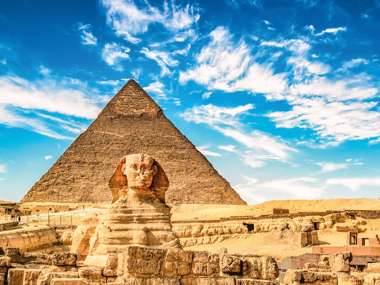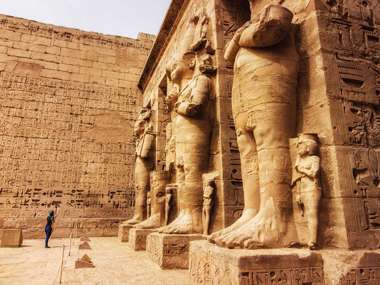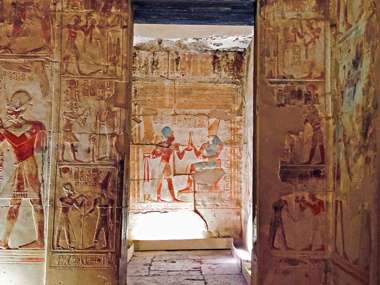A personal account from a Nile Cruise
I’m lucky enough to have been to Egypt twice and sailed along the Nile on two different but equally fantastic vessels. I was worried that my trip wouldn’t be as good the second time around; that the sites may lose their wonder on a return visit – but I couldn’t have been more wrong.
From studying the hieroglyphics that adorn the walls of Karnak, to a once-in-a-lifetime hot air balloon ride over the Valley of the Kings and visiting a Nubian family in their own home while enjoying a refreshing cup of mint tea – my second visit to Egypt couldn’t have been more magical. The wonderful thing about Egypt is that it is so full of treasures, that you could never tire of cruising along this fascinating river, whether you do a classic week on the Nile or the whole 600 miles from Aswan to Cairo.

A second visit is almost required to fully appreciate its beauty, allowing you to appreciate the little things you didn’t notice the first time. You can also relax without fear of missing out on the perfect photo opportunity, you may even be tempted to put your camera away and just soak it all in. There is also the added joy of travelling with companions who are experiencing these wonders for the first time, their delight reminding you of your own past travels.
Aboard the Moroccan inspired MS Darakum, we made the most of the delicious international cuisine, plus Egyptian delicacies and were spoilt by our attentive hosts who go above and beyond to ensure you have the journey of a lifetime. My favourite way to spend the time while sailing is enjoying an afternoon tea on the sun deck, taking the opportunity to slip into the plunge pool to cool off. Simply sitting on the sun deck and watching daily life is fascinating enough in itself, you will see children swimming and playing along the banks as well as local people fishing for Nile perch, mullet and eels. The wide leaves of banana trees line this epic river, with tall reeds crowding the banks and providing shelter for a whole host of birdlife which can be spotted by the keen-eyed twitchers amongst us.

It was wonderful to discover things that are ancient but new to me, like the awe-inspiring twin temples of Abu Simbel. This site is best approached from the water, letting the anticipation build as the towering figures of Ramses II loom ever larger on the horizon - you can experience this exclusively on Lake Nasser & the Nile!
On the road to Abydos, children and local people smiled and waved as we drove past them, tourists not being an everyday occurrence on this stretch of the Nile. We watched as chickens ran alongside us down narrow streets populated with cars you haven’t seen since the 1970’s. The smell of flatbreads filled the air, the dough puffing up on the hot griddles and being sold by the bag. When you arrive at Abydos itself, the site is situated in the middle of the town with the call to prayer sounding out across the temple complex. Best known for its palimpsest relief with two overlapping inscriptions, the titles of Ramesses II are superimposed on those of his predecessor Seti I. These unique markings were wrongly interpreted in the past as an out-of-place artifact depicting a helicopter!
A highlight for me on this trip was gazing up at the azure-coloured ceilings of Denderah, recently cleared of the centuries of smoke damage caused by the cooking fires of the Christians who used these holy temples as their homes. It was a wonderful insight into the former glory of this striking temple. Even more impressive to me and far lesser-known is Medinet Habu – one of the west bank's most underrated sites. Much of the original paintwork can still be seen adorning the pillars and ceilings, as well as huge amounts of well-preserved reliefs and towering statues of Ramesses III. Above the tide mark from one of the Nile’s great floods, the colourful blues, yellows, and greens are almost as vibrant as the day they were painted. Away from the more crowded tourist hot spots of Luxor and Karnak, we explored this temple in quiet contemplation, marvelling at this most miraculously preserved necropolis.
Of course, no visit to Egypt is complete without visiting the iconic Pyramids, no less-impressive on second viewing. Whilst in Cairo we were lucky enough to visit the Grand Egyptian Museum before it opens to the public and were blown away by the grandeur and scale of the new building, not to mention the countless treasures it holds.


Most importantly I felt completely safe during my time in Egypt, the local people are friendly and love to talk about their country (as well as trying to sell you a bargain or two!) at the bazaars and local markets. They are very welcoming and couldn’t be more pleased to see tourists visiting their remarkable country. Our local guide was also with us every step of the way. Every guide is a trained Egyptologist who can answer any question you might have, whatever your area of interest and level of knowledge, whether you are coming to Egypt with a blank slate or as a passionate Egyptophile – you will learn more than you could have ever imagined.







